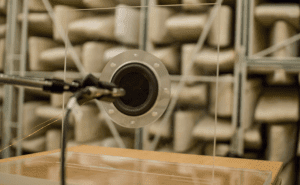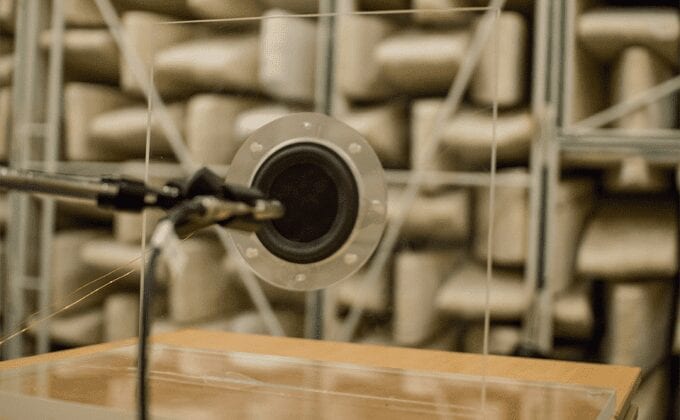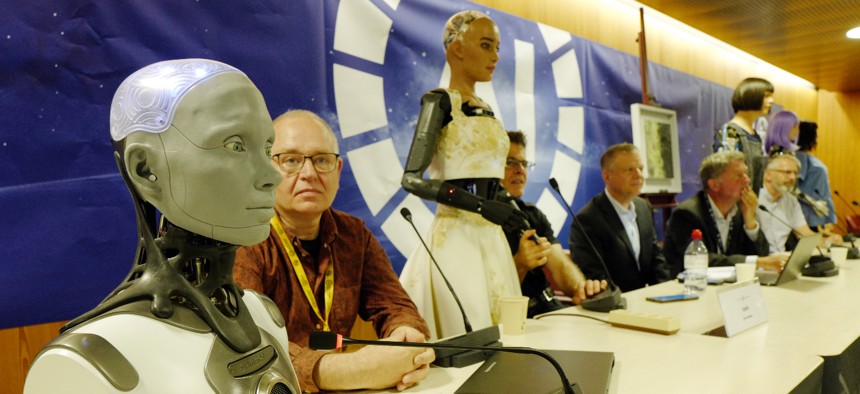
The world’s first magnetic cellulose membrane loudspeakers
Throughout the ages, Sweden has relied on its vast forests as a source of sustenance and economic growth. Now add the world’s first magnetic cellulose membrane loudspeakers to the list of products that can be produced from wood.
These flat, sonorous and environmentally-friendly speakers are made with a new material derived from wood pulp – magnetic cellulose gel – which was developed at KTH Royal Institute of Technology. Unlike ordinary speakers, they require no heavy permanent magnets.
Richard Olsson, a KTH researcher in chemical sciences who supervised the doctoral research behind the magnetic cellulose gel, says the new material may open the way for innovations in such areas as acoustic applications for automobiles.
Olsson and his colleagues at KTH, Lars Berglund, also a researcher in chemical sciences, and Valter Ström, a scientist in engineering physics of materials, recently demonstrated the speakers for the first time. Their paper is published by the Royal Society of Chemistry.
“This is, to our knowledge, the first reported magnetic speaker membrane,” Olsson says. He adds that the sound quality is at least as good as in conventional speakers – possibly better because of the even distribution of forces created in the membrane.
The idea is to show the potential of natural and environmentally-sustainable materials in everyday products. “We want to use this first prototype to see how the cellulose can be used in new applications,” he says.
He and his research colleagues have patented the material, which was created by attaching magnetic nanoparticles to cellulose nanofibrils. The cellulose comes from renewable wood pulp and involves environmentally-friendly water chemistry. The gel is cast into a membrane which is then allowed to dry. The membrane’s strength is that it has a rapid reaction capability, which means a high degree of precision in sound reproduction.
Ordinary speakers include a large permanent magnet. The speaker cone’s movement, which creates sound waves, is driven by a voice coil that is wrapped around the permanent magnet and attached to the cone.
With the cellulose membrane speakers, the magnetic particles are part of the membrane itself. The KTH speaker has a coil, but it has no direct contact with the cone, so the only thing that creates sound is the movement of air. All of these components can be manufactured at a very small scale.
The Latest Google Headlines on:
Magnetic cellulose membrane
[google_news title=”” keyword=”Magnetic cellulose membrane” num_posts=”10″ blurb_length=”0″ show_thumb=”left”]
The Latest Bing News on:
Magnetic cellulose membrane
- New Membrane Technology Converts Saltwater Gradients into Poweron April 24, 2024 at 5:00 pm
The researchers developed a RED membrane prototype that featured separate channels for ion and electron transport, enhancing its efficiency. They achieved this by embedding a negatively charged ...
- American science association honors Iowa State innovators for advancing scienceon April 18, 2024 at 9:14 am
The American Association for the Advancement of Science is honoring five Iowa State University researchers for “their scientifically or socially distinguished efforts to advance science." Two of the ...
The Latest Google Headlines on:
Cellulose membrane speakers
[google_news title=”” keyword=”cellulose membrane speakers” num_posts=”10″ blurb_length=”0″ show_thumb=”left”]
The Latest Bing News on:
Cellulose membrane speakers
- Membrane Technology Forum to focus on cleaning, sanitation and wastewateron April 26, 2024 at 5:00 am
In addition to several hours of dedicated networking, this year's event will feature more than 20 presentations led by some of the progressive thinking membrane experts. Below you will find more ...











